Study on Mechanism and Influencing Factors of Wheel Strengthening and Toughening of High-Speed and Heavy-Load Train
Abstract
:1. Introduction
2. Materials and Methods
2.1. Mechanical Tests
2.2. Fracture Analysis
3. Results and Discussion
3.1. Mechanical Property
3.1.1. Influence of Carbon on Wheel Strength and Toughness
3.1.2. Influence of Other Elements on Wheel Strength and Toughness
3.2. Toughness Mechanism Analysis
3.2.1. SEM Analysis of Fracture
3.2.2. OM Analysis of Fracture
4. Conclusions
- Carbon plays a decisive role in the performance of high-speed and heavy-load train wheels. When the content of carbon is between 0.69% and 0.74%, the impact decline is the slowest, the fluctuation is the smallest, the strength is higher, and it has a good matching of strength and toughness.
- Si/Mn is an important strengthening element of wheels and has little influence on their toughness. However, when Si content reaches above 0.70%, the strength increases by 6%, while the impact minimum value decreases by 30%. Mn content exceeding 1% will increase the instability of toughness, doubling the difference between the maximum and minimum of impact.
- The elements Cr, V, Ni, and Mo increase the strength of the wheel, but reduce the mean impact of the wheel by approximately 20%, then present great difficulties in the process control of microstructures such as bainite on the surface of the wheel.
- The different toughness of the wheel is reflected in the dimple band of the fracture, the source of the crack, and the pattern of cleavage.
- The mechanism of random fluctuation of impact toughness is that there is a critical difference in grain size, which leads to a concentrated crack source during impact fracture, resulting in brittle fracture and abnormal reduction of toughness.
- The abnormal fluctuation of toughness on wheels is mainly due to the different interfacial stress of the grain size. It remains necessary to improve the toughness level of wheels, in addition to refining the grain, but also to control the grain grade difference.
Author Contributions
Funding
Data Availability Statement
Acknowledgments
Conflicts of Interest
References
- Roney, M. Common Elements of Successful Heavy Haul Railways: A Worldwide Perspective. In Proceedings of the 8th International Heavy Haul Conference (CD Edition), Rio de Janeiro, Brazil, 14–16 June 2005. [Google Scholar]
- Faccoli, M.; Petrogalli, C.; Lancini, M.; Andrea Ghidini, A.; Mazzù, A. Rolling Contact Fatigue and Wear Behavior of High-Performance Railway Wheel Steels Under Various Rolling-Sliding Contact Conditions. J. Mater. Eng. Perform. 2017, 26, 3271–3284. [Google Scholar] [CrossRef]
- Faccoli, M.; Ghidini, A.; Mazzù, A. Changes in the Microstructure and Mechanical Properties of Railway Wheel Steels as a Result of the Thermal Load Caused by Shoe Braking. Metall. Mater. Trans. A Phys. Metall. Mater. Sci. 2019 50, 1701–1714. [CrossRef]
- Leso, T.P.; Siyasiya, C.W.; Mostert, R.J.; Moema, J. Study of rolling contact fatigue, rolling and sliding wear of class B wheel steels against R350HT and R260 rail steels under dry contact conditions using the twin disc setup. Tribol. Int. 2022, 174, 107711. [Google Scholar] [CrossRef]
- Nejad, R.M.; Berto, F. Fatigue crack growth of a railway wheel steel and fatigue life prediction under spectrum loading conditions. Int. J. Fatigue 2022, 157, 106722. [Google Scholar] [CrossRef]
- Ravi, A.M.; Sietsma, J.; Santofimia, M.J. Exploring bainite formation kinetics distinguishing grain-boundary and autocatalytic nucleation in high and low-Si steels. Acta Mater. 2016, 105, 155–164. [Google Scholar] [CrossRef] [Green Version]
- Mishra, K.; Singh, A. Effect of interlamellar spacing on fracture toughness of nano-structured pearlite. Mater. Sci. Eng. A Struct. Mater. Prop. Microstruct. Process. 2017, 706, 22–26. [Google Scholar] [CrossRef]
- Association of American Railroads (AAR). AAR M-107/M-208; Standard: AAR Manual of Standards and Recommended Practices: Wheels and Axles Wheels. Association of American Railroads: Washington, DC, USA, 2020.
- Gao, B.; Tan, Z.; Liu, Z.; Gao, G.; Zhang, M.; Zhang, G.; Bai, B. Influence of non-uniform microstructure on rolling contact fatigue behavior of high-speed wheel steels. Eng. Fail. Anal. 2019, 100, 485–491. [Google Scholar] [CrossRef]
- Zeng, D.; Lu, L.; Gong, Y. Optimization of strength and toughness of railway wheel steel by alloy design. Mater. Des. 2016, 92, 998–1006. [Google Scholar] [CrossRef]
- Wu, M.; Zhao, F.; Che, J.L. The toughening mechanisms of microstructural variation and Ni addition in direct-cooled microalloyed ferrite-pearlite steels. Mater. Sci. Eng. A Struct. Mater. Prop. Microstruct. Process. 2018, 738, 353–361. [Google Scholar] [CrossRef]
- Singh, U.P.; Popli, A.M.; Jain, D.K. Influence of Microalloying on Mechanical and Metallurgical Properties of Wear Resistant Coach and Wagon Wheel Steel. J. Mater. Eng. Perform. 2003, 12, 573–580. [Google Scholar] [CrossRef]
- Khiratkar, V.N.; Mishra, K.; Srinivasulu, P. Effect of inter-lamellar spacing and test temperature on the Charpy impact energy of extremely fine pearlite. Mater. Sci. Eng. A Struct. Mater. Prop. Microstruct. Process. 2019, 754, 622–627. [Google Scholar] [CrossRef]
- Ostash, O.P.; Anofriev, V.H.; Andreiko, M. On the concept of selection of steels for high-strength railroad wheels. Mater. Sci. 2013, 48, 697–703. [Google Scholar] [CrossRef]
- Zhou, S.T.; Li, Z.D.; Yang, C.F. Cleavage fracture and microstructural effects on the toughness of a medium carbon pearlitic steel for high-speed railway wheel. Mater. Sci. Eng. A 2019, 761, 138036. [Google Scholar] [CrossRef]
- Tervo, H.; Kaijalainen, A.; Pikkarainen, T. Effect of impurity level and inclusions on the ductility and toughness of an ultra-high-strength steel. Mater. Sci. Eng. A Struct. Mater. Prop. Microstruct. Process. 2017, 697, 184–193. [Google Scholar] [CrossRef]
- Strnadel, B.; Hausild, P. Statistical scatter in the fracture toughness and Charpy impact energy of pearlitic steel. Mater. Sci. Eng. A Struct. Mater. Prop. Microstruct. Process. 2008, 486, 208–214. [Google Scholar] [CrossRef]
- Takashima, Y.; Ohata, M.; Minami, F. Analysis of Statistical Scatter in Charpy Impact Toughness. Mater. Sci. Forum 2014, 783, 2394–2399. [Google Scholar]
- Wang, G.Z.; Liu, Y.G.; Chen, J.H. Investigation of cleavage fracture initiation in notched specimens of a C-Mn steel with carbides and inclusions. Mater. Sci. Eng. A Struct. Mater. Prop. Microstruct. Process. 2004, 369, 181–191. [Google Scholar] [CrossRef]
- Zhou, S.; Zuo, Y.; Li, Z. Microstructural analysis on cleavage fracture in pearlitic steels. Mater. Charact. 2016, 119, 110–113. [Google Scholar] [CrossRef]
- Wang, G.Z.; Chen, J.H.; Wang, J.G. On the measurement and physical meaning of the cleavage fracture stress in steel. Int. J. Fract. 2002, 118, 211–227. [Google Scholar] [CrossRef]
- Jiang, B.; Wu, M.; Zhang, M. Microstructural characterization, strengthening and toughening mechanisms of a quenched and tempered steel: Effect of heat treatment parameters. Mater. Sci. Eng. A Struct. Mater. Prop. Microstruct. Process. 2017, 707, 306–314. [Google Scholar] [CrossRef]
- Hong, Z.; Zhang, X.; Zhang, C.; Wen, Z.; Jin, X.; Yan, Q. Achievement of high strength-ductility combination in railway wheel steel with thin pearlite and spherical cementite via composition and undercooling design. Mater. Res. Express 2019, 6, 016546. [Google Scholar] [CrossRef]
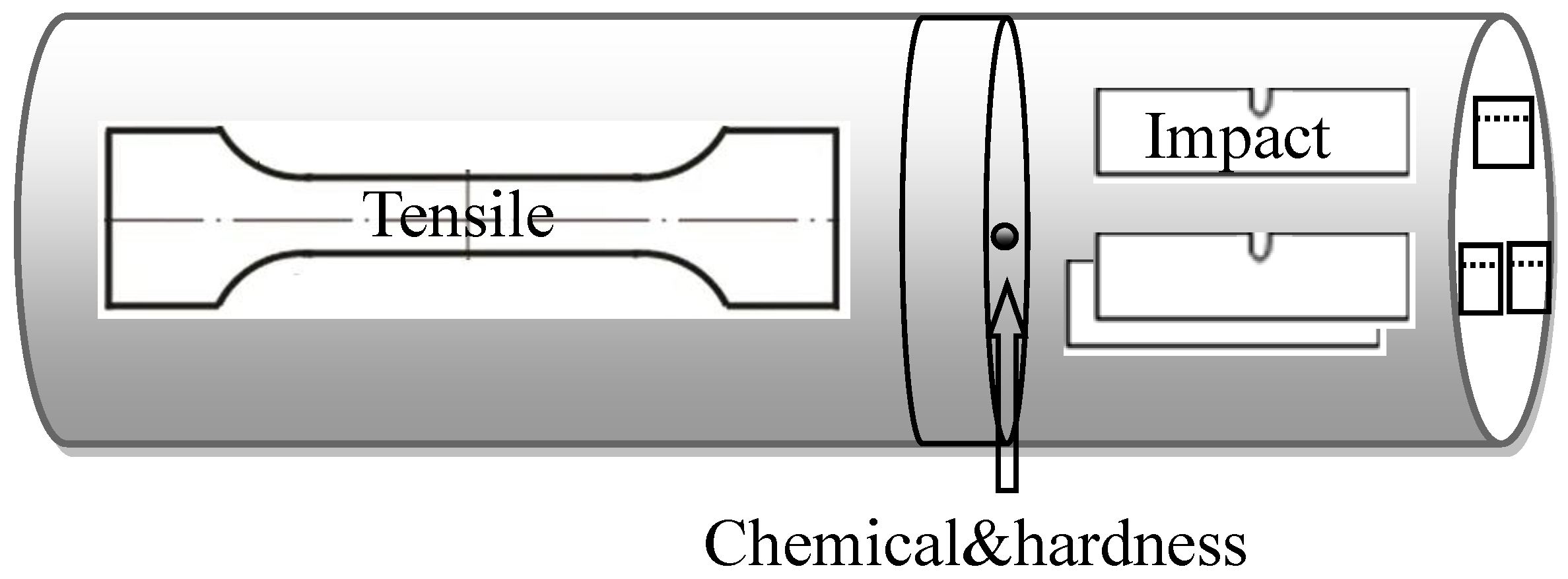

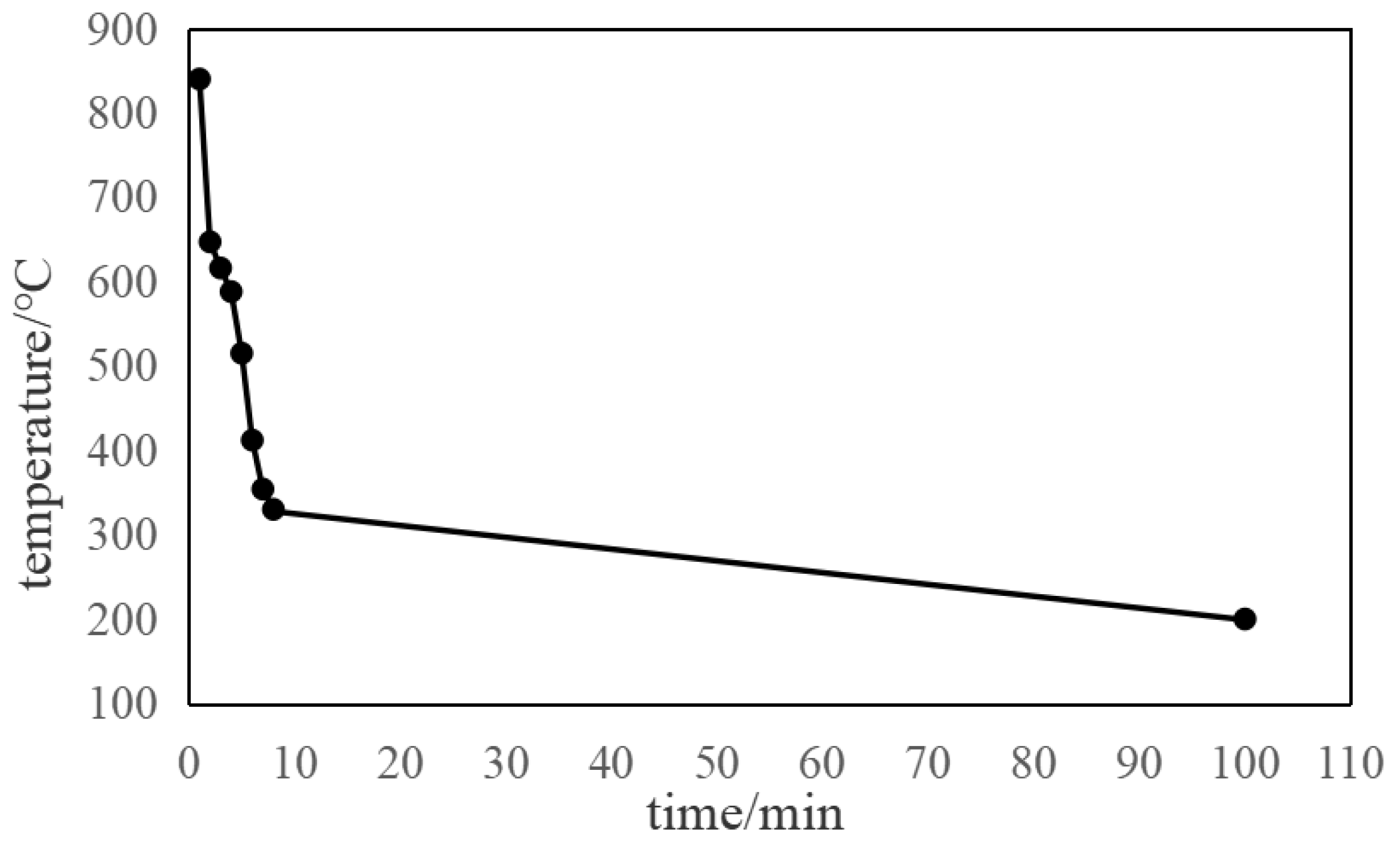
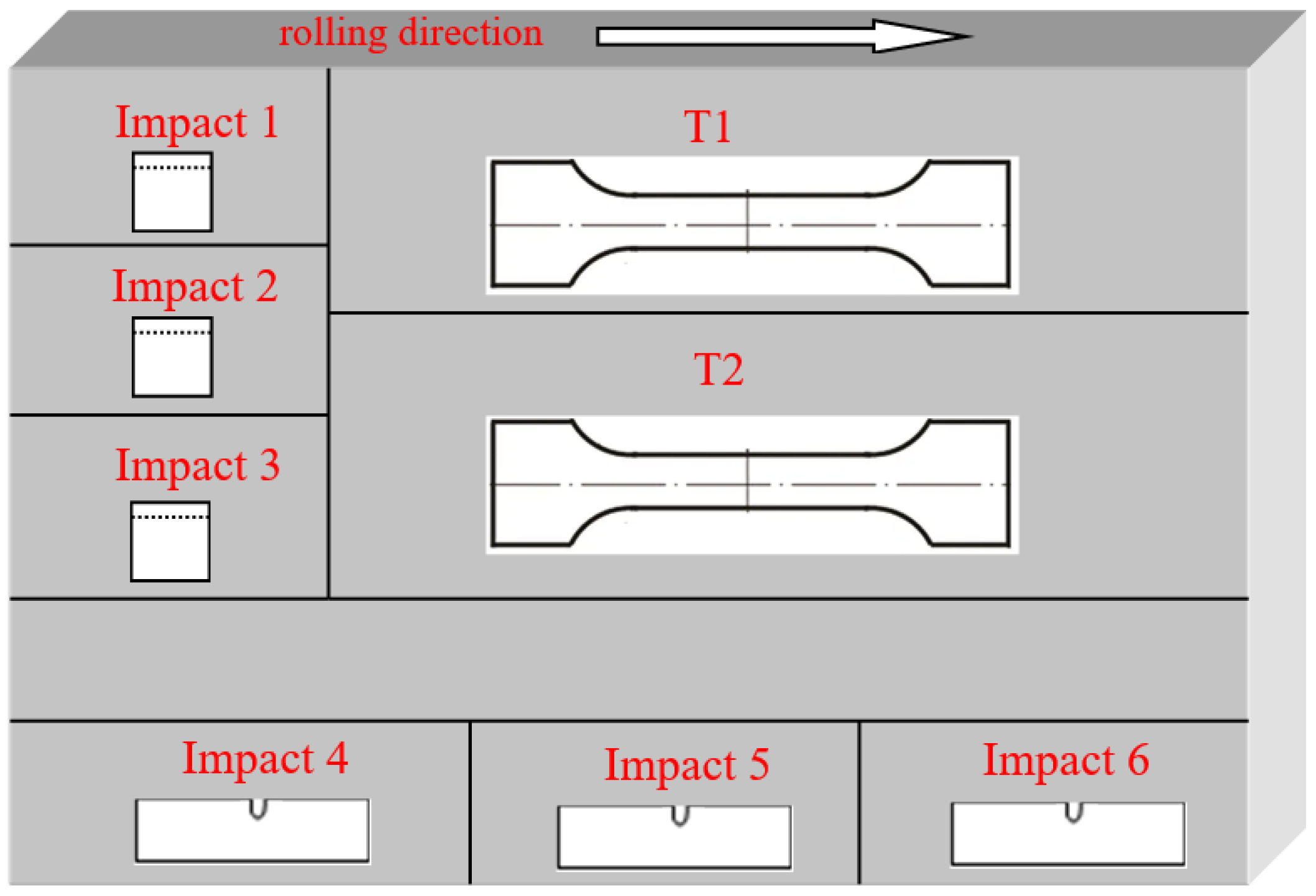
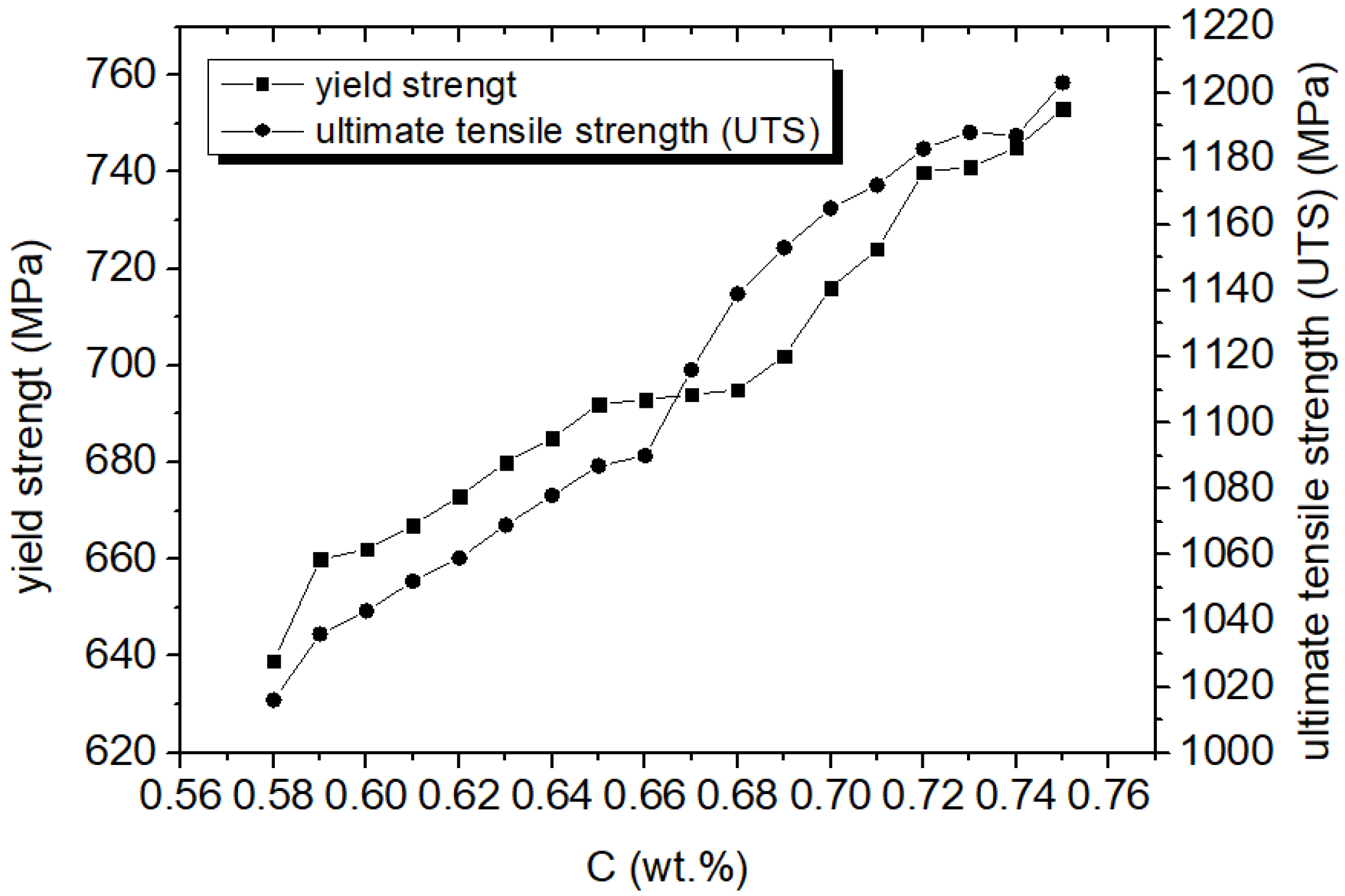
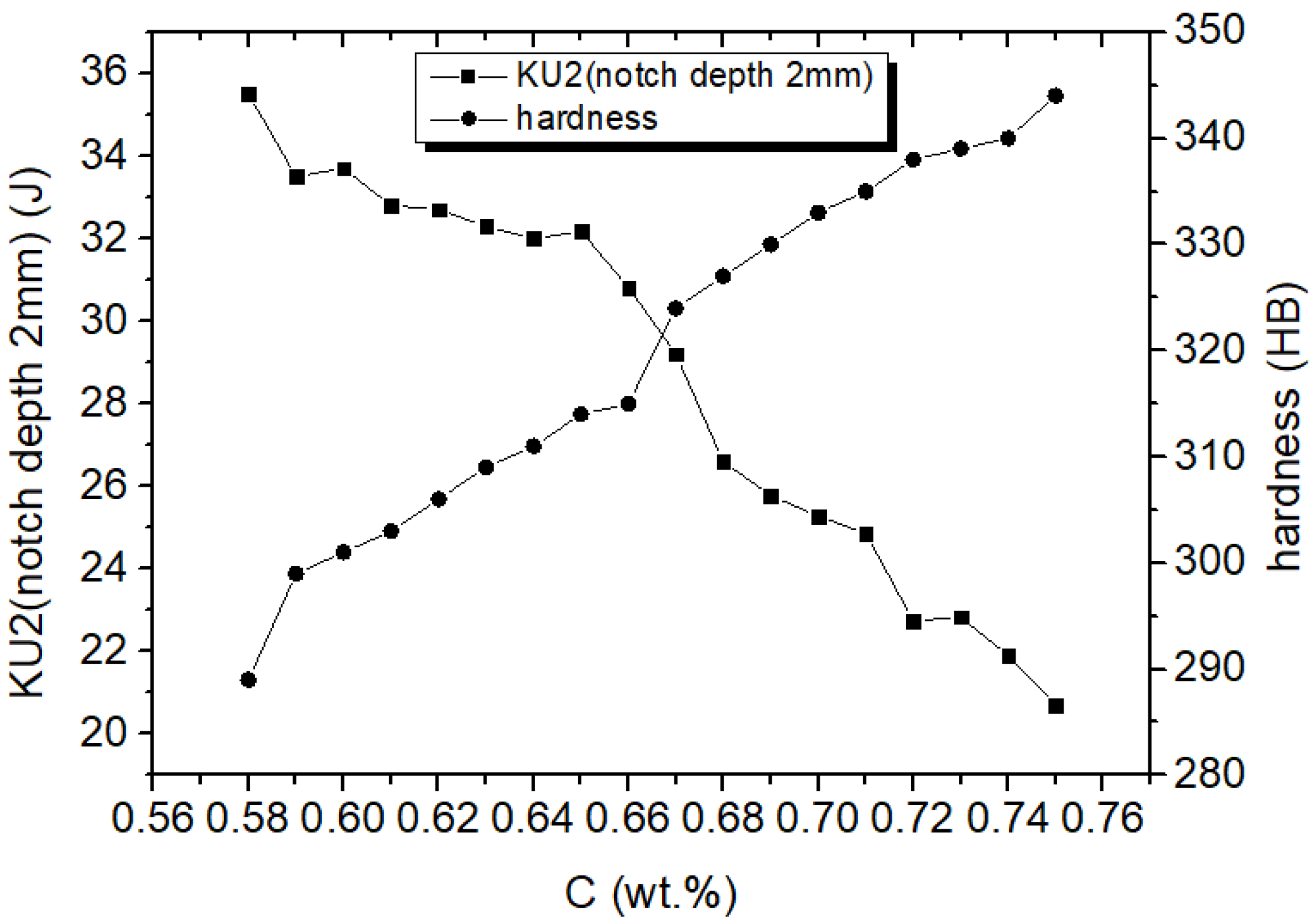
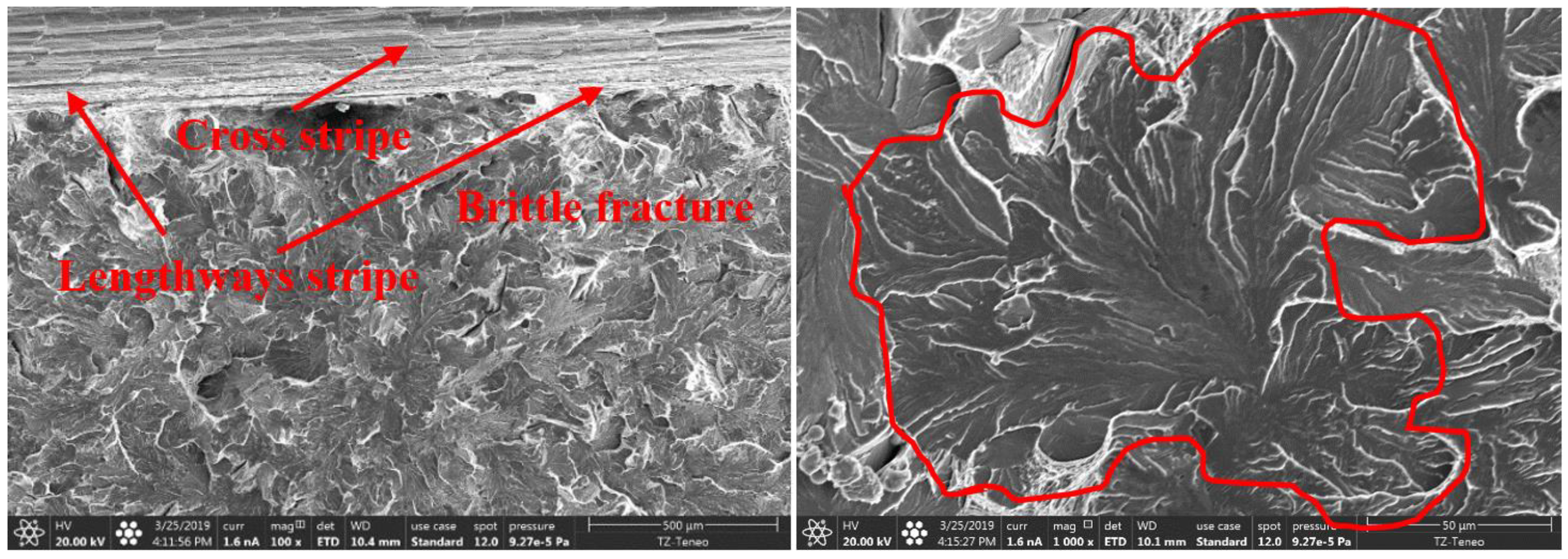
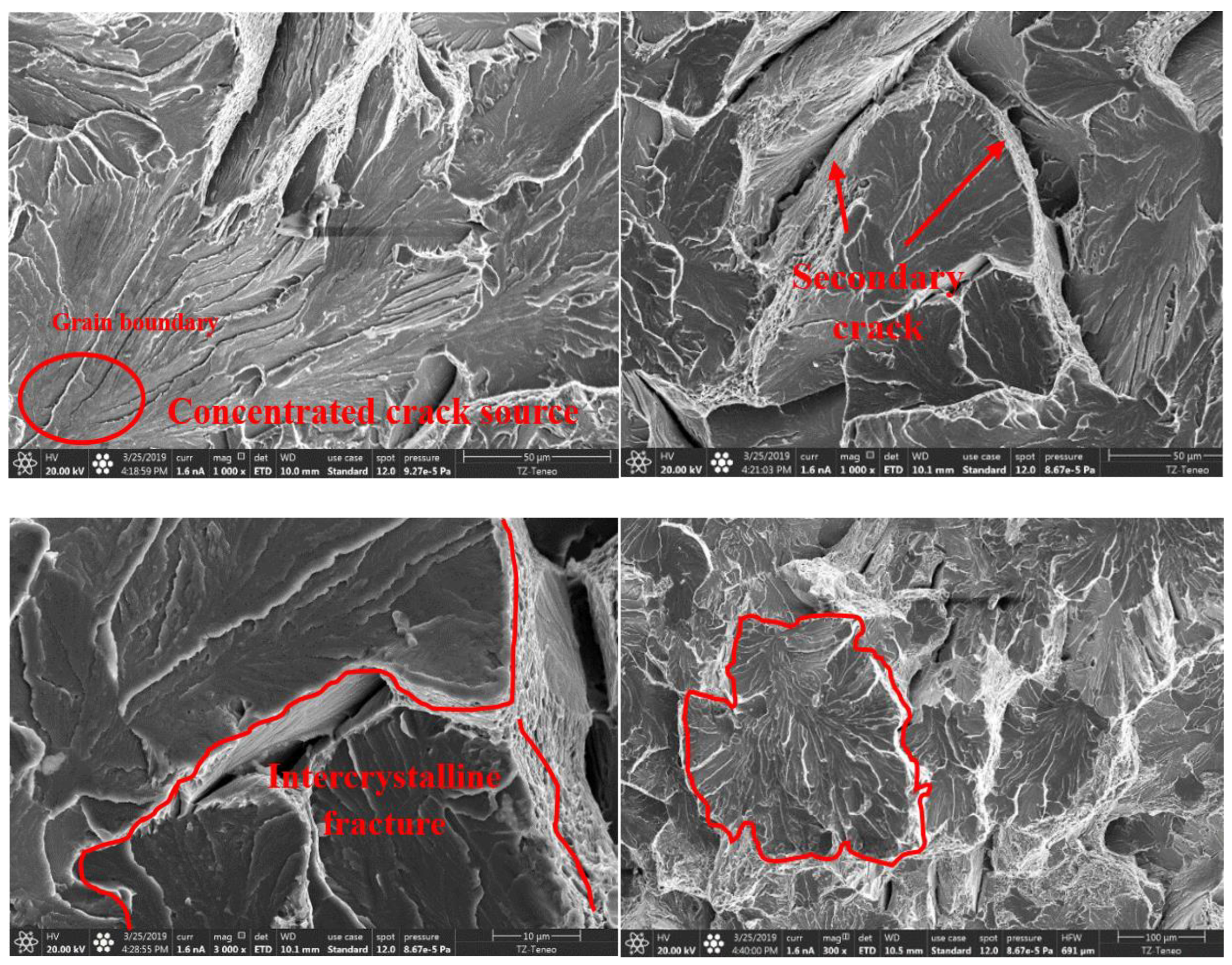

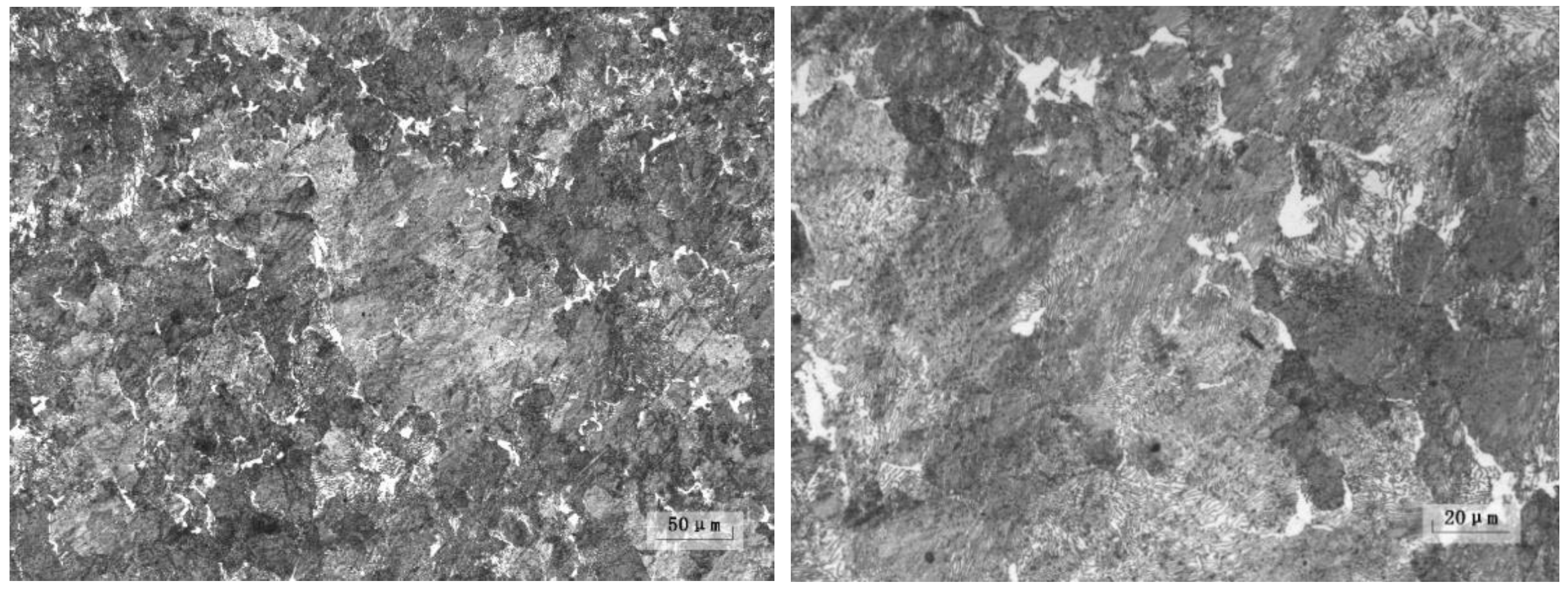
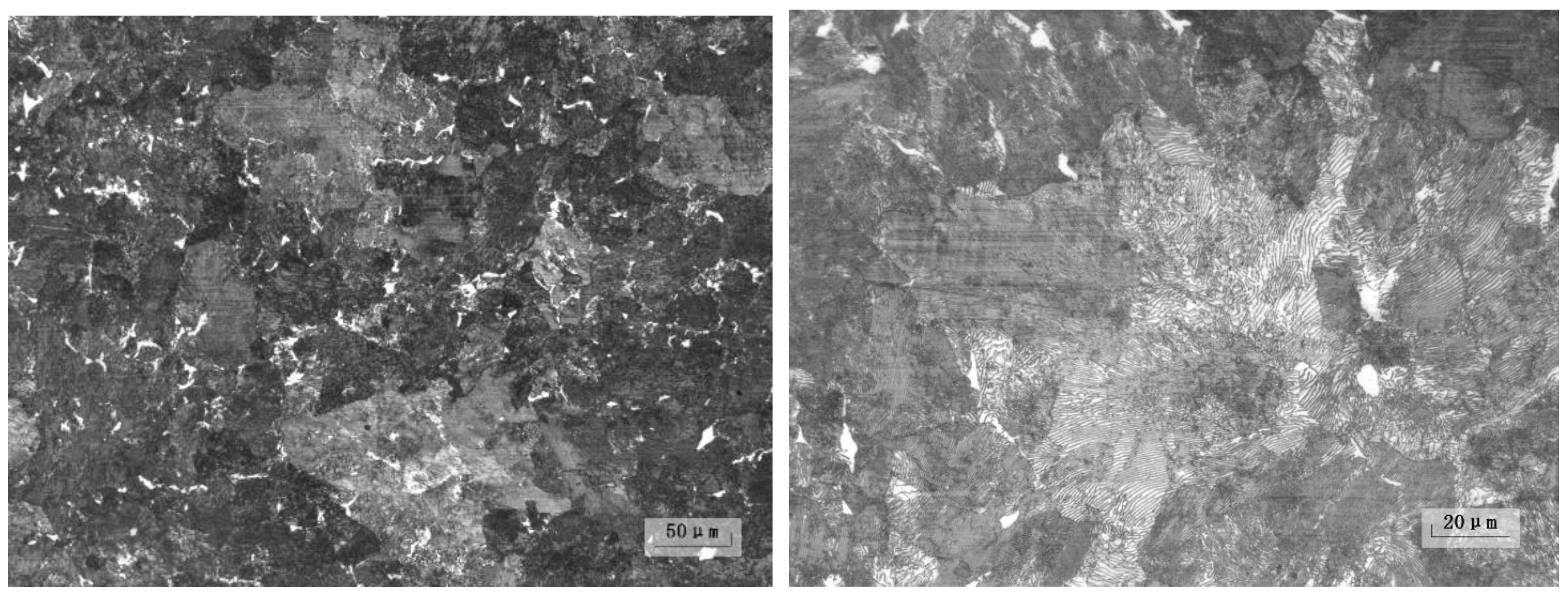
| Material | C/wt.% | Si/wt.% | Mn/wt.% | P/wt.% | S/wt.% | Cr/wt.% | Ni/wt.% | Cu/wt.% | Mo/wt.% | V/wt.% |
|---|---|---|---|---|---|---|---|---|---|---|
| CL60 | 0.55~0.65 | 0.17~0.37 | 0.50~0.80 | ≤0.035 | ≤0.040 | ≤0.25 | ≤0.25 | ≤0.25 | - | - |
| AAR C | 0.67~0.77 | 0.15~1.00 | 0.60~0.90 | ≤0.030 | 0.005~0.040 | ≤0.30 | ≤0.25 | ≤0.35 | ≤0.10 | ≤0.04 |
| Pos. | Cr = 0.22 wt.% | Cr = 0.16 wt.% | Si = 0.77 wt.% | Si = 0.31 wt.% | Mn = 1.02 wt.% | Mn = 0.79 wt.% | ||||||
|---|---|---|---|---|---|---|---|---|---|---|---|---|
| Rm | Impact | Rm | Impact | Rm | Impact | Rm | Impact | Rm | Impact | Rm | Impact | |
| /Mpa | KU2/J | /Mpa | KU2/J | /Mpa | KU2/J | /Mpa | KU2/J | /Mpa | KU2/J | /Mpa | KU2/J | |
| T1/1-3 | 1001 | 16/14/14 | 1012 | 25/26/19 | 1229 | 13/10/17 | 1179 | 17/14/21 | 1187 | 16/12/23 | 1169 | 16/24/25 |
| T2/4-6 | 980 | 23/21/12 | 959 | 37/18/21 | 1201 | 23/11/18 | 1127 | 22/16/25 | 1150 | 21/29/20 | 1138 | 23/26/27 |
| Sample | V/wt.% | Ni/wt.% | Mo/wt.% | Rm/Mpa | Rp0.2/Mpa | A5/% | Z/% | KU2 (Notch Depth 2 mm)/J |
|---|---|---|---|---|---|---|---|---|
| 1# | 0.002 | 0.011 | 0.001 | 1153 | 649 | 15.5 | 32.0 | 26/29/23 |
| 2# | 0.060 | 0.009 | 0.001 | 1205 | 689 | 14.5 | 31.5 | 27/23/22 |
| 3# | 0.006 | 0.100 | 0.001 | 1197 | 674 | 15.5 | 28.5 | 18/24/22 |
| 4# | 0.003 | 0.010 | 0.011 | 1184 | 689 | 16.5 | 32.0 | 23/26/27 |
| Sample | ReH/MPa | Rm/MPa | A5/% | Z/% | KU2(+20 °C, Notch Depth 2 mm)/J | Under Tread 30 mm/HB | ||
|---|---|---|---|---|---|---|---|---|
| 1# | 2# | 3# | ||||||
| Rim | 703 | 1109 | 15.0 | 41 | 29.2 | 20.0 | 27.5 | 314 |
| Web | / | 888 | 14.5 | / | 9.1 | 24.5 | 18.5 | |
| Sample | Inclusion | Microstructure | Grain Size (Grade) | ||||
|---|---|---|---|---|---|---|---|
| A Sulfur | B Aluminate | C Silicate | D Globular Oxide | Ds Single Globular Oxide | |||
| 1# | 0 | 0.5 | 0 | 0.5 | 0 | Pearlite + fine pearlite + a little ferrite | 6.5 and a little 3.5 |
| 2# | 0 | 0 | 0.5 | 0.5 | 0 | Pearlite + fine pearlite + a little ferrite | 6.5 and a little 4.0, some field 3.0 |
Disclaimer/Publisher’s Note: The statements, opinions and data contained in all publications are solely those of the individual author(s) and contributor(s) and not of MDPI and/or the editor(s). MDPI and/or the editor(s) disclaim responsibility for any injury to people or property resulting from any ideas, methods, instructions or products referred to in the content. |
© 2023 by the authors. Licensee MDPI, Basel, Switzerland. This article is an open access article distributed under the terms and conditions of the Creative Commons Attribution (CC BY) license (https://creativecommons.org/licenses/by/4.0/).
Share and Cite
Jia, T.; Shen, Z.; Liu, C.; Zhao, X.; Zhang, X. Study on Mechanism and Influencing Factors of Wheel Strengthening and Toughening of High-Speed and Heavy-Load Train. Crystals 2023, 13, 81. https://doi.org/10.3390/cryst13010081
Jia T, Shen Z, Liu C, Zhao X, Zhang X. Study on Mechanism and Influencing Factors of Wheel Strengthening and Toughening of High-Speed and Heavy-Load Train. Crystals. 2023; 13(1):81. https://doi.org/10.3390/cryst13010081
Chicago/Turabian StyleJia, Tuosheng, Zhigang Shen, Cuirong Liu, Xinglong Zhao, and Xiaofeng Zhang. 2023. "Study on Mechanism and Influencing Factors of Wheel Strengthening and Toughening of High-Speed and Heavy-Load Train" Crystals 13, no. 1: 81. https://doi.org/10.3390/cryst13010081





